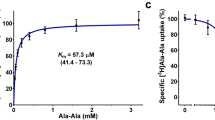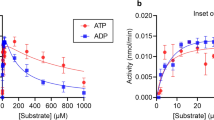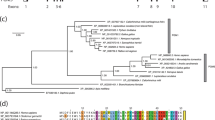Abstract
Dipeptidyl peptidase IV (DPP-IV/CD26) is a multifunctional type II transmembrane serine peptidase. This enzyme contributes to the regulation of various physiological processes, including blood sugar homeostasis, by cleaving peptide hormones, chemokines and neuropeptides. We have determined the 2.5 Å structure of the extracellular region of DPP-IV in complex with the inhibitor valine-pyrrolidide. The catalytic site is located in a large cavity formed between the α/β-hydrolase domain and an eight-bladed β-propeller domain. Both domains participate in inhibitor binding. The structure indicates how substrate specificity is achieved and reveals a new and unexpected opening to the active site.
This is a preview of subscription content, access via your institution
Access options
Subscribe to this journal
Receive 12 print issues and online access
$189.00 per year
only $15.75 per issue
Buy this article
- Purchase on Springer Link
- Instant access to full article PDF
Prices may be subject to local taxes which are calculated during checkout




Similar content being viewed by others
Accession codes
References
Mentlein, R. Dipeptidyl-peptidase IV (CD26)-role in the inactivation of regulatory peptides. Regul. Pept. 85, 9–24 (1999).
Korom, S. et al. Inhibition of CD26/dipeptidyl peptidase IV activity in vivo prolongs cardiac allograft survival in rat recipients. Transplantation 63, 1495–1500 (1997).
Tanaka, S. et al. Suppression of arthritis by the inhibitors of dipeptidyl peptidase IV. Int. J. Immunopharmacol. 19, 15–24 (1997).
Steinbrecher, A. et al. Targeting dipeptidyl peptidase IV (CD26) suppresses autoimmune encephalomyelitis and up-regulates TGF-β 1 secretion in vivo. J. Immunol. 166, 2041–2048 (2001).
De Meester, I., Korom, S., Van Damme, J. & Scharpe, S. CD26, let it cut or cut it down. Immunol. Today 20, 367–375 (1999).
Marguet, D. et al. Enhanced insulin secretion and improved glucose tolerance in mice lacking CD26. Proc. Natl. Acad. Sci. USA 97, 6874–6879 (2000).
Deacon, C.F., Hughes, T.E. & Holst, J.J. Dipeptidyl-peptidase-iv inhibition potentiates the insulinotropic effect of glucagon-like peptide-1 in the anesthetized pig. Diabetes 47, 764–769 (1998).
Pederson, R.A. et al. Enhanced glucose-dependent insulinotropic polypeptide secretion and insulinotropic action in glucagon-like peptide-1 receptor (−/−)-mice. Diabetes 47, 1046–1052 (1998).
Pauly, R.P. et al. Improved glucose tolerance in rats treated with the dipeptidyl peptidase IV (CD26) inhibitor ile-thiazolidide. Metab. Clin. Exp. 48, 385–389 (1999).
Balkan, B., Kwasnik, L., Miserendino, R., Holst, J.J. & Li, X. Inhibition of dipeptidyl peptidase IV with NVP-DPP728 increases plasma GLP-1(7-36 amide) concentrations and improves oral glucose tolreance in obese Zucker rats. Diabetology 42, 1324–1331 (1999).
Ahren, B. et al. Inhibition of dipeptidyl peptidase IV improves metabolic control over a 4-week study period in type 2 diabetes. Diabetes Care 25, 869–875 (2002).
Kameoka, J., Tanaka, T., Nojima, Y., Schlossman, S.F. & Morimoto, C. Direct association of adenosine deaminase with a T cell activation antigen, CD26. Science 261, 466–469 (1993).
Girardi, A.C.C., Degray, B.C., Nagy, T., Biemesderfer, D. & Aronson, P.S. Association of Na+-H+ exchanger isoform NHE3 and dipeptidyl peptidase IV in the renal proximal tubule. J. Biol. Chem. 276, 46671–46677 (2001).
Ishii, T. et al. CD26-mediated signaling for T cell activation occurs in lipid rafts through its association with CD45RO. Proc. Natl. Acad. Sci. USA 98, 12138–12143 (2001).
Morimoto, C. & Schlossman, S.F. The structure and function of cd26 in the T-cell immune-response. Immunol. Rev. 161, 55–70 (1998).
Wesley, U.V., Albino, A.P., Tiwari, S. & Houghton, A.N. A role for dipeptidyl peptidase IV in suppressing the malignant phenotype of melanocytic. J. Exp. Med. 190, 311–322 (1999).
Marguet, D. et al. cDNA cloning for mouse thymocyte-activating molecule. A multifunctional ecto-dipeptidyl peptidase IV (CD26) included in a subgroup of serine proteases. J. Biol. Chem. 267, 2200–2208 (1992).
Gorrell, M.D., Gysbers, V. & McCaughan, G.W. CD26: a multifunctional integral membrane and secreted protein of activated lymphocytes. Scand. J. Immunol. 54, 249–264 (2001).
Fulop, V., Bocskei, Z. & Polgar, L. Prolyl oligopeptidase: an unusual β-propeller domain regulates proteolysis. Cell 94, 161–170 (1998).
Abbott, C.A.G. & Gorrell, M.D. The family of CD26/DPIV and related ectopeptidases. in Ectopeptidases: CD13/Aminopeptidase N and CD26/Dipeptidylpeptidase IV in Medicine and Biology (eds. Langner, J & Ansorge, S.) 171–184 (Kluwer/Plenum, New York; 2002).
Abbott, C.A., McCaughan, G.W., Levy, M.T., Church, W.B. & Gorrell, M.D. Binding to human dipeptidyl peptidase IV by adenosine deaminase and antibodies that inhibit ligand binding involves overlapping, discontinuous sites on a predicted β propeller domain. Eur. J. Biochem. 266, 798–810 (1999).
Smith, T.F., Gaitatzes, C., Saxena, K. & Neer, E.J. The WD repeat: a common architecture for diverse functions. Trends Biochem. Sci. 24, 181–185 (1999).
Fulop, V. & Jones, D.T. β-propellers: structural rigidity and functional diversity. Curr. Opin. Struct. Biol. 9, 715–721 (1999).
Fulop, V., Szeltner, Z. & Polgar, L. Catalysis of serine oligopeptidases is controlled by a gating filter mechanism. EMBO Rep. 1, 277–281 (2000).
Abbott, C.A., McCaughan, G.W. & Gorrell, M.D. Two highly conserved glutamic acid residues in the predicted β propeller domain of dipeptidyl peptidase IV are required for its enzyme activity. FEBS Lett. 458, 278–284 (1999).
Reva, B., Finkelstein, A. & Topiol, S. Threading with chemostructural restrictions method for predicting fold and functionally significant residues: application to dipeptidylpeptidase IV (DPP-IV). Proteins 47, 180–193 (2002).
Brandt, W. Development of a tertiary-structure model of the C-terminal domain of DPP IV. Adv. Exp. Med. Biol. 477, 97–101 (2000).
De Meester, I., Vanhoof, G., Lambeir, A.M. & Scharpé, S. Use of immobilized adenosine-deaminase (EC 3.5.4.4) for the rapid purification of native human CD26 dipeptidyl peptidase IV (EC 3.4. 14.5). J. Immunol. Methods 189, 99–105 (1996).
Otwinowski, Z. & Minor, W. Processing of X-ray diffraction data collected in oscillation mode. Methods Enzymol. 276, 307–326 (1997).
Collaborative Computational Project, Number 4. The CCP4 suite: programs for protein crystallography. Acta Crystallogr. D 50, 760–763 (1994).
Terwilliger, T.C. & Berendzen, J. Automated MAD and MIR structure solution. Acta Crystallogr. D 55, 849–861 (1999).
de La Fotelle, E. & Bricogne, G. Maximum-likelihood heavy-atom parameter refinement for multiple isomorphous replacement and multiwavelength anomalous diffraction methods. Methods Enzymol. 276, 472–494 (1997).
Abrahams, J.P. & Leslie, A.G.W. Methods used in the structure determination of bovine mitochondrial F1 ATPase. Acta Crystallogr. D 52, 30–42 (1996).
Brunger, A.T. et al. Crystallography & NMR System: a new software suite for macromolecular structure determination. Acta Crystallogr. D 54, 905–921 (1998).
Nicholls, A., Sharp, K.A. & Honig, B. Protein folding and association: insights from the interfacial and thermodynamic properties of hydrocarbons. Proteins 11, 281–296 (1991).
Acknowledgements
We thank P.F. Nielsen for MALDI-MS analysis, L. Thim for N-terminal amino acid sequencing and S. Kaltoft, B.B. Knudsen, L.L. Nilausen Schmidt and B. Rosenberg for technical assistance. L. Gordon is thanked for help during data collection at ESRF and L.F. Iversen, S.E. Bjørn, A. Kanstrup and R.D. Carr for fruitful discussions and comments on the manuscript.
Author information
Authors and Affiliations
Corresponding author
Ethics declarations
Competing interests
The authors declare no competing financial interests.
Rights and permissions
About this article
Cite this article
Rasmussen, H., Branner, S., Wiberg, F. et al. Crystal structure of human dipeptidyl peptidase IV/CD26 in complex with a substrate analog. Nat Struct Mol Biol 10, 19–25 (2003). https://doi.org/10.1038/nsb882
Received:
Accepted:
Published:
Issue Date:
DOI: https://doi.org/10.1038/nsb882
This article is cited by
-
Distal mutation V486M disrupts the catalytic activity of DPP4 by affecting the flap of the propeller domain
Acta Pharmacologica Sinica (2022)
-
Role and mechanism(s) of incretin-dependent therapies for treating diabetes mellitus
Environmental Science and Pollution Research (2022)
-
Dipeptidyl peptidase 4 inhibitors in the treatment of type 2 diabetes mellitus
Nature Reviews Endocrinology (2020)
-
Crystal structures of a bacterial dipeptidyl peptidase IV reveal a novel substrate recognition mechanism distinct from that of mammalian orthologues
Scientific Reports (2018)
-
Structural insights of dipeptidyl peptidase-IV inhibitors through molecular dynamics-guided receptor-dependent 4D-QSAR studies
Molecular Diversity (2018)



